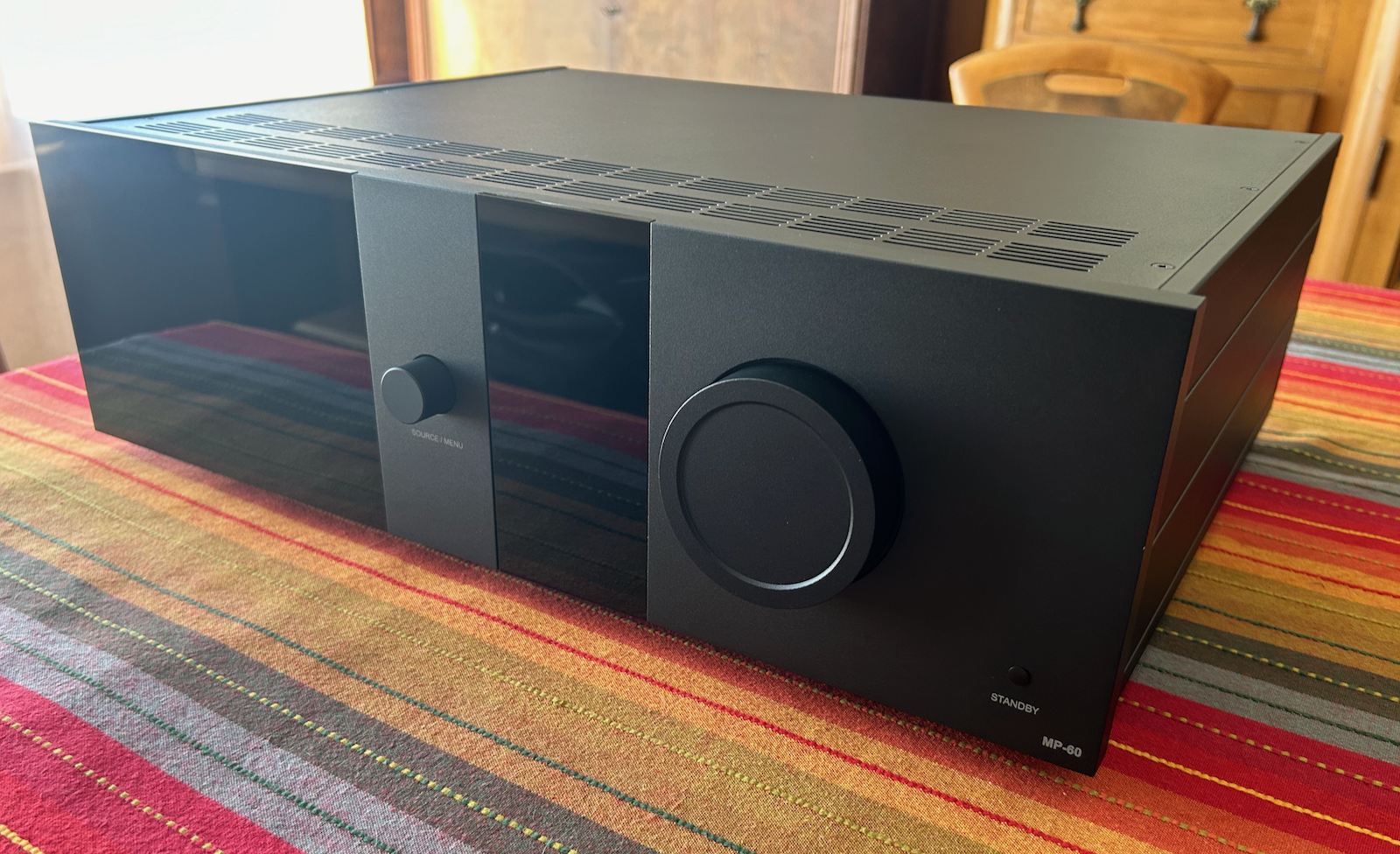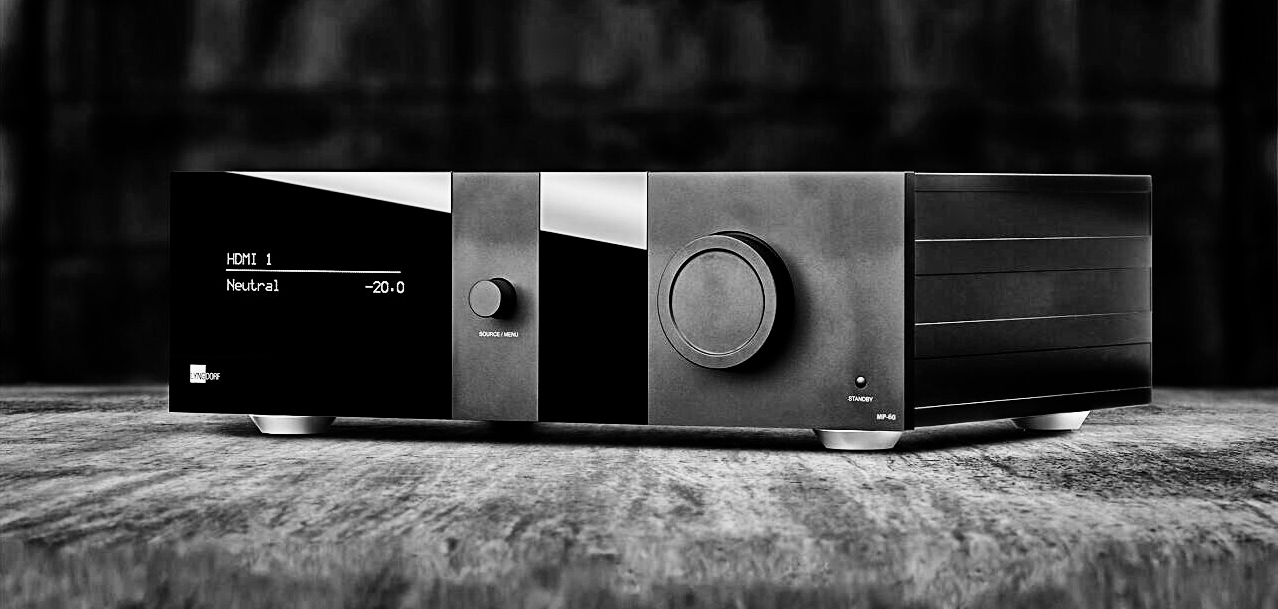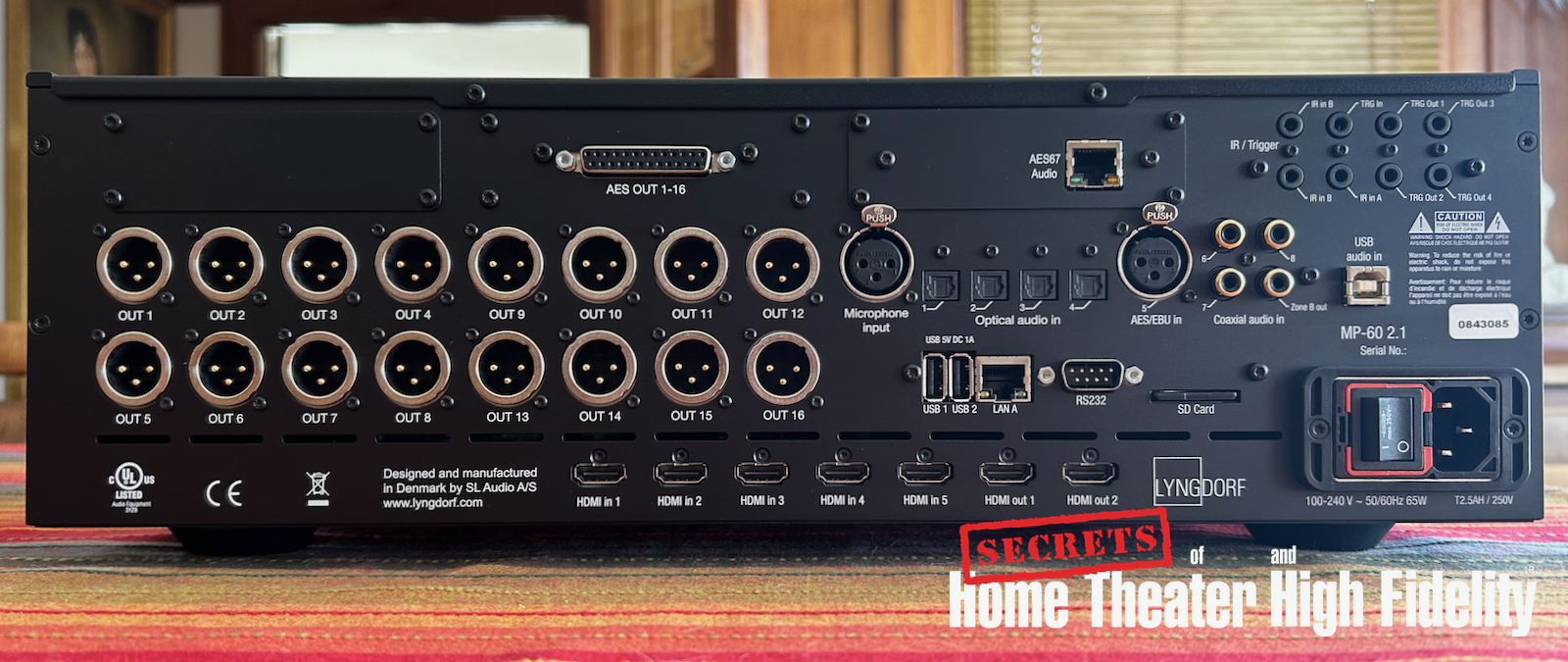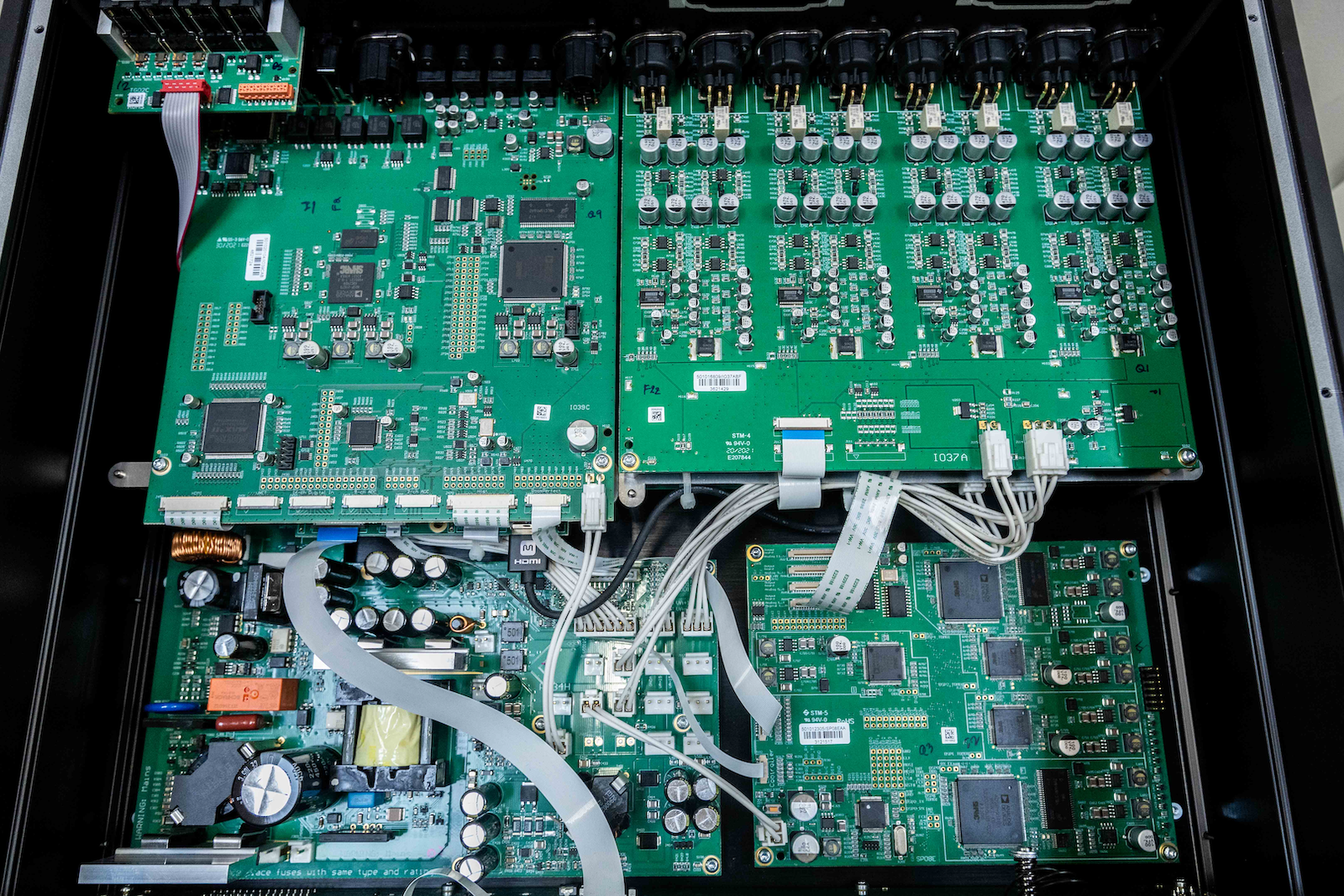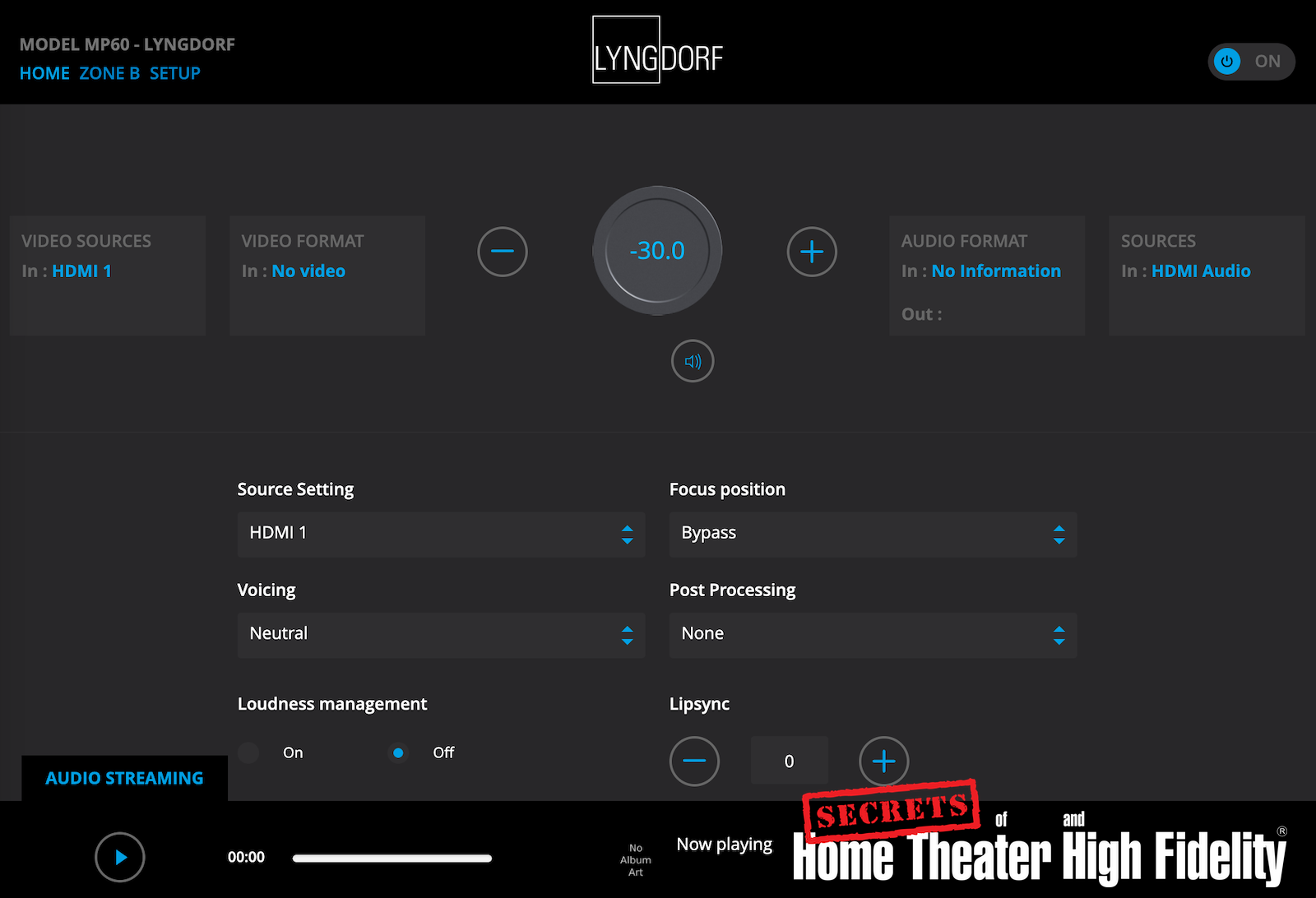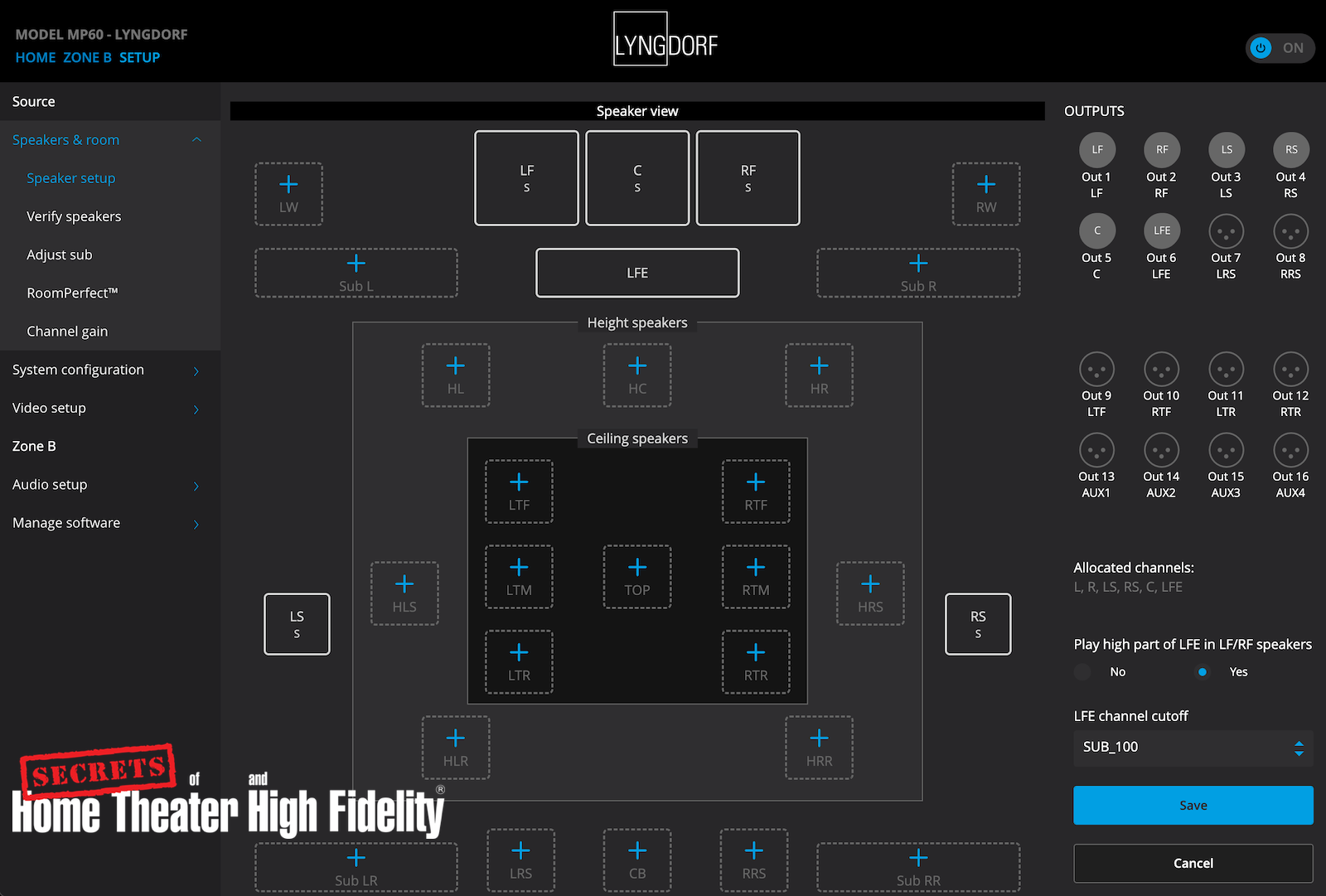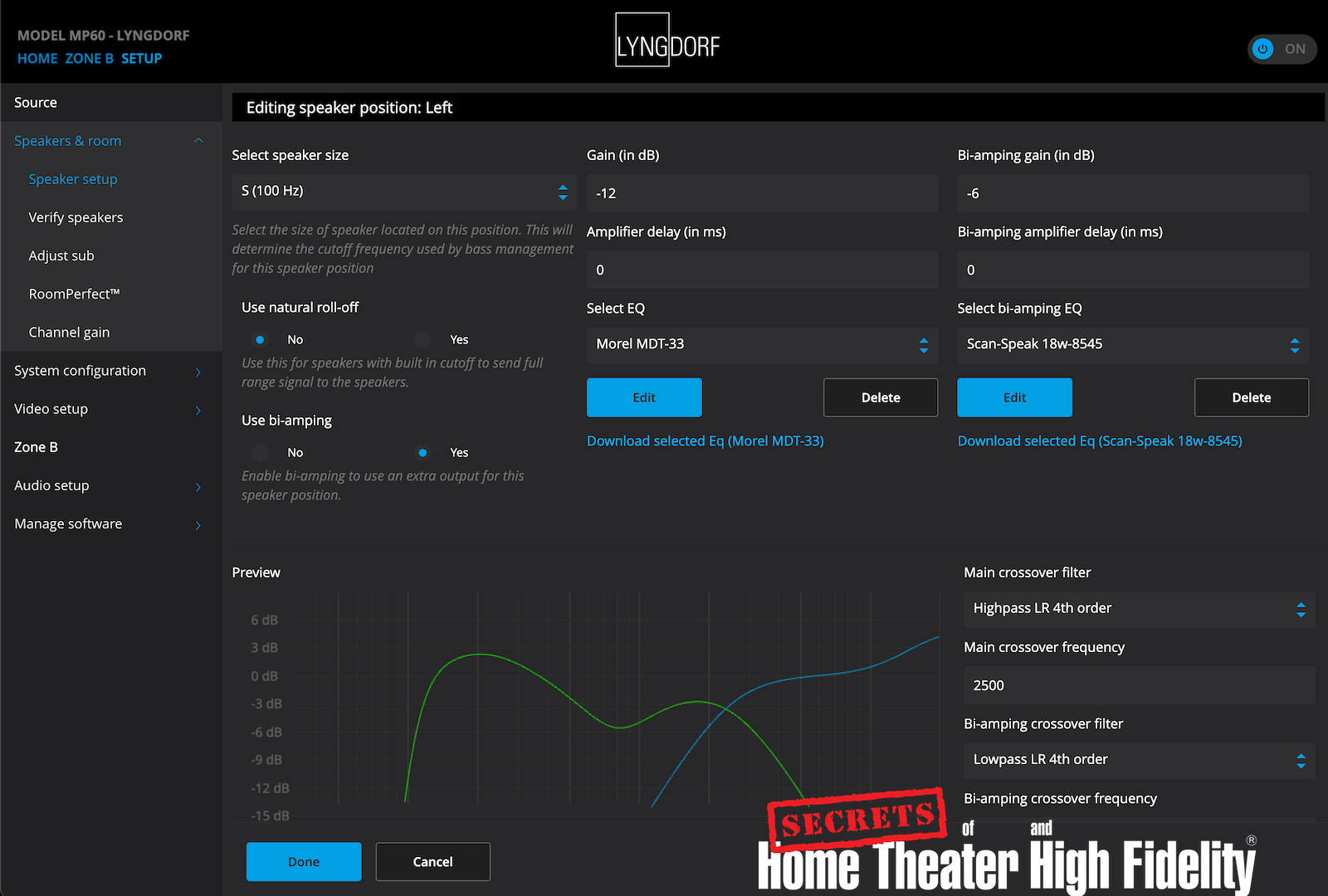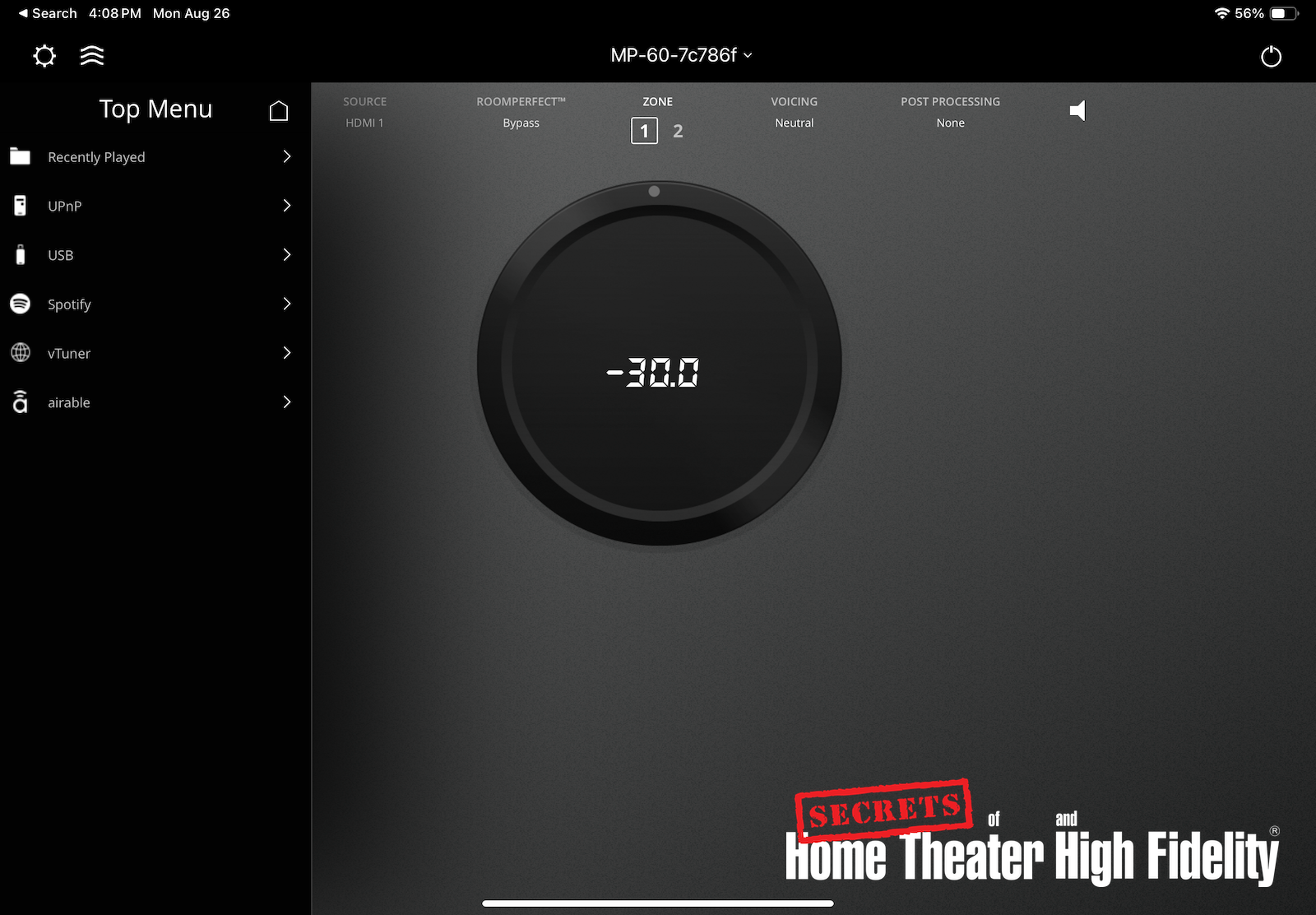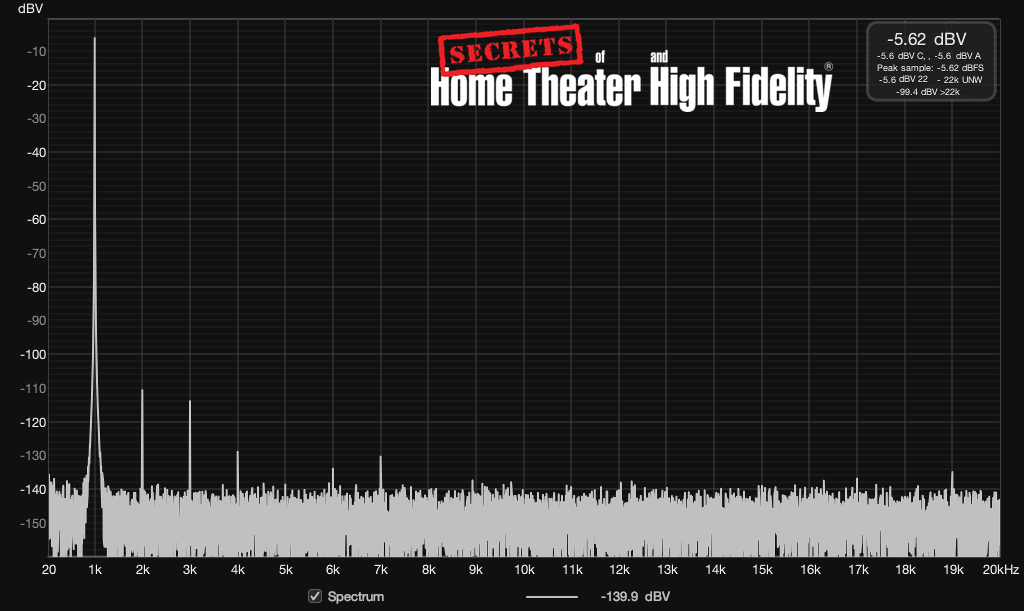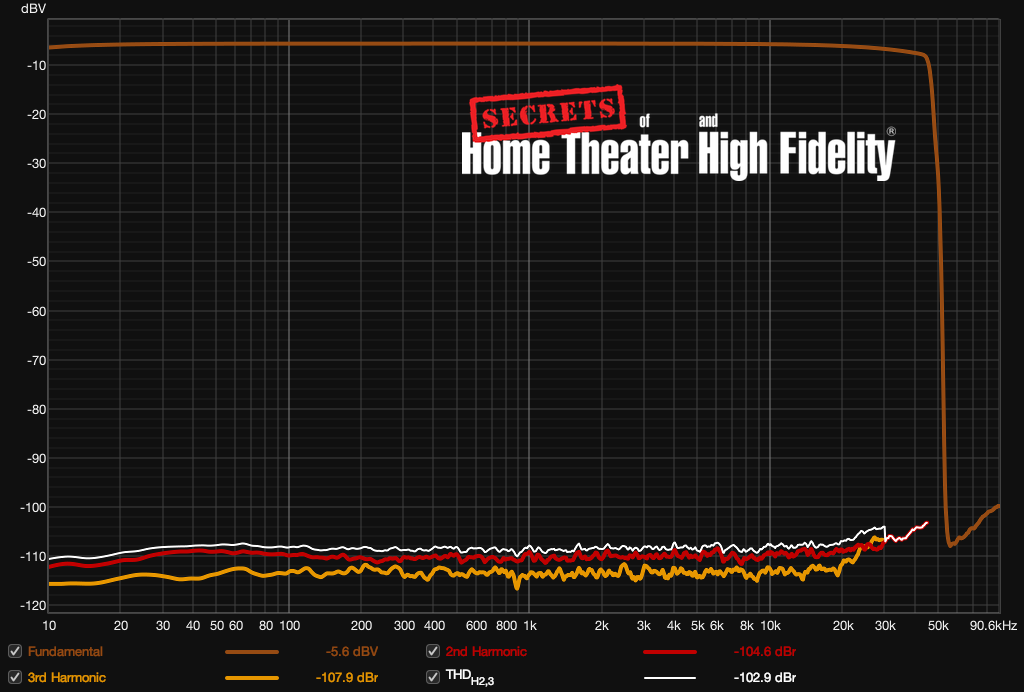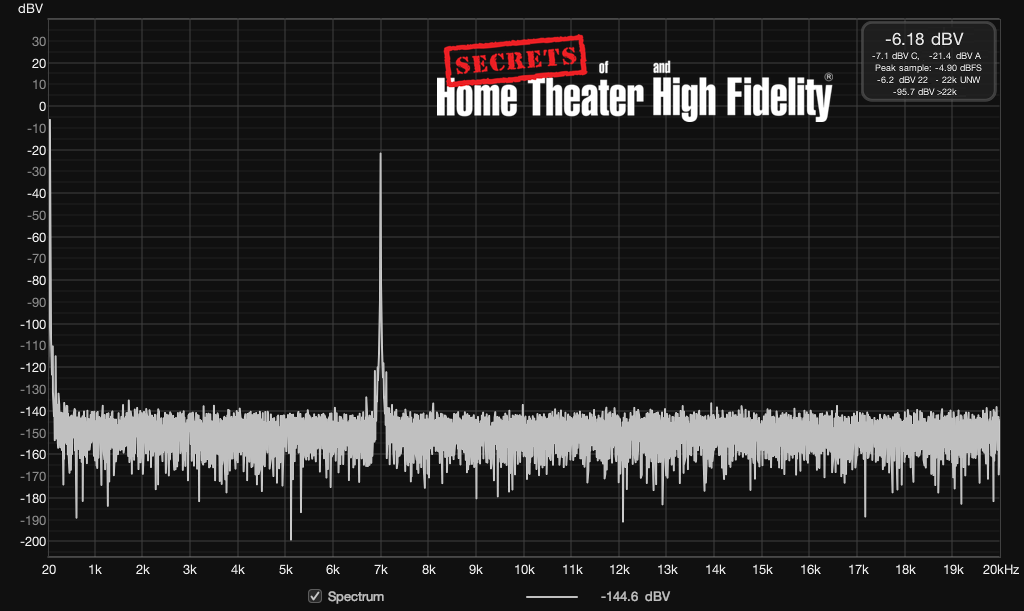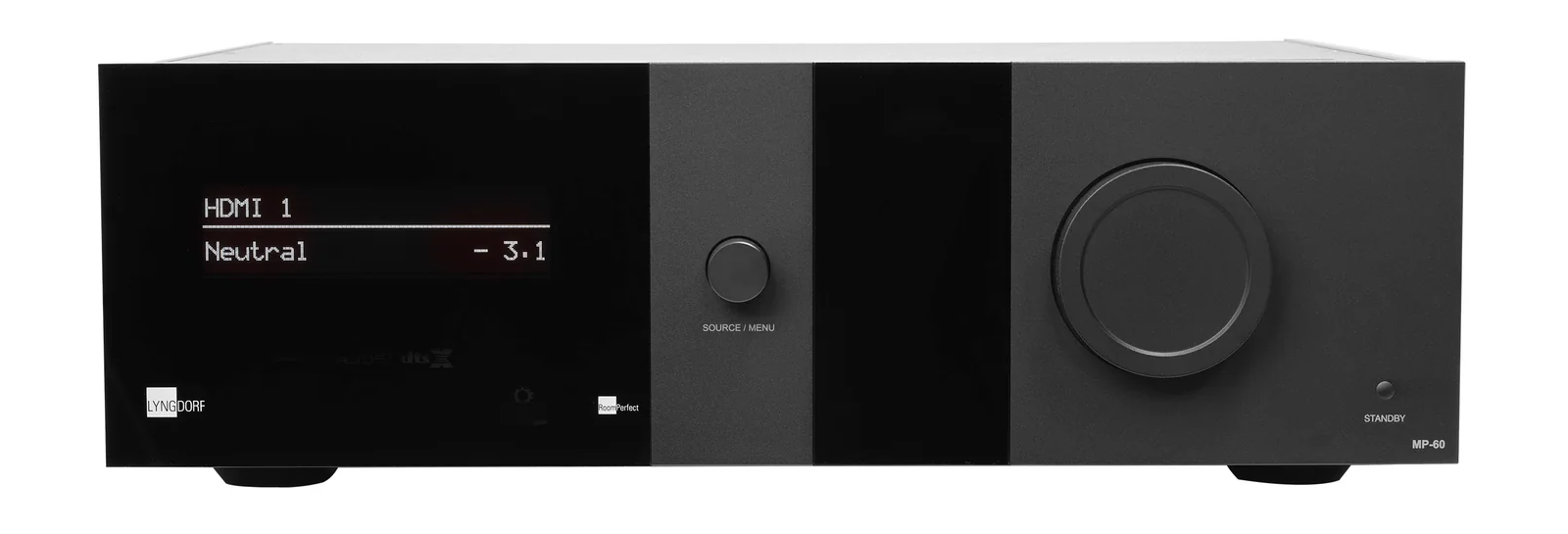The answer is, as you might expect, “something special”.
The MP-60 2.1 is the current flagship home theater processor from Lyngdorf, recently receiving an upgrade to HDMI 2.1 (hence the 2.1 designation). The MP-60 2.1 offers 16 channels of balanced analog outputs but can be configured with optional AES/EBU input and output modules to allow the unit to operate entirely in the digital domain. Though the MP-60 is designed primarily with the custom installer (CI) market in mind, I found the power and flexibility of the product to be a very compelling option for audiophiles looking for high levels of performance, flexibility, and control.
Lyngdorf MP-60 2.1 Home Theater Processor Highlights
- Elegant, minimal Scandinavian looks.
- Reference-level sound and video quality combining clarity, nuance, and power.
- Amazing tuning capabilities supporting bi-amp and tri-amp configurations with crossovers and full parametric equalization on every channel, making fully active speaker configurations possible without external crossovers.
- RoomPerfect™ room correction—easy to configure and gets great results while preserving the sound signature of your speakers.
- Comprehensive control via on-screen, web-based, and mobile applications.
- Roon Ready, for flawless streaming and Roon application control.
- Support for modern and legacy Dolby, DTS, and Auro codecs and upmixers.
- Weighted volume knob with “physics” that carries through the tablet and phone apps.
- The ability to save collections of parametric EQ filters as “voicings” allows easy tuning of sound for different tastes or content.
Peter Lyngdorf is a Danish entrepreneur who owned well-known audiophile brands Snell Acoustics and NAD Electronics before founding his eponymous brand just before the turn of the century. More recently, Peter Lyngdorf collaborated with Bruno Putzeys and Lars Risbo to form Purifi ApS, which produces innovative class D amplifiers and loudspeaker drivers. Lyngdorf has, since its founding, focused on digital HiFi products and digital signal processing for room correction so a product like a home theater processor leverages these core competencies. This expertise attracted the attention of the well-known American HiFi company McIntosh, which licenses both Lyngdorf’s hardware and software for use in its flagship MX line of home theater processors. It should be noted that McIntosh modifies and augments this hardware and software to align them with the sound and features that McIntosh is known for.
Decoding:
16 decoding/upmixing channels, Dolby Atmos®, DTS:X Pro (14 channels), AURO-3D® (14 channels), all legacy codecs
Post-processing options:
Dolby Surround, AURO-MATIC®, DTS Neural:X
Audio inputs:
5 x HDMI (1 x HDMI eARC) ≤192kHz/24bit, 1 x AES/EBU S/P-DIF input (≤192kHz/24bit), 3 x S/P-DIF coaxial inputs (≤192kHz/24bit), 4 x S/P-DIF optical inputs (≤96Hz/24bit), 1 x USB audio input (≤192kHz/32bit), 1 x microphone input (XLR) for RoomPerfect™
Audio outputs:
16 x XLR analog outputs (8 Vrms max.), 1 x SPDIF coax digital ZONE output (Fix 96kHz/24bit)
Audio specifications:
Frequency response: ±0.5dB from 20 to 20,000 Hz, Total harmonic distortion: 0.005% max from 20 to 20,000 Hz
EQ:
RoomPerfect™, Subwoofer level assistant, 32 x adjustable voicings holding ≤8 shelving, high/low pass or parametric filters with adjustable gain and Q
Media player:
Internet radio (vTuner, airable), AirPlay 2, Spotify Connect, Tidal Connect with Dolby Atmos Music, Roon Ready, DLNA Support of FAT32-based media storage
Video inputs:
5 x HDMI™ (2.1 – HDCP 2.3), accepts 8k30 RGB/YCbCr 4:4:4 10-bit video, 8k60 YCbCr 4:2:0 10-bit high-definition video, and 4k120 4:4:4 10-bit high frame rate video, Variable refresh rate (VRR), fast vactive (FVA), and auto low latency mode (ALLM) support. Accepts HDR, Dolby Vision™, and HLG
Video outputs:
2 x HDMI (HDCP 2.3)
Video scaling:
Upscaling of all video to 4K ultra high definition, no downscaling of 4K video
Control interfaces:
1 x DB9 RS232 connector, 2 x IR sensor inputs, 1 x IR output (loop from one of the sensor inputs), 1 x trigger input, 4 x trigger outputs, 1 x RJ45 ethernet LAN connector, 2 x USB A connectors, 1 x SD card slot, (Backup – storage for system software and settings) Accessories included: RoomPerfect™ microphone, Microphone stand, Microphone cable, and RF remote control.
Optional module:
16-channel DCI-compliant digital AES/EBU input for movie servers (supports up to 32bit/192kHz), 16-channel digital AES/EBU output module (always 24bit, 48kHz or 96kHz Selectable), 16-channel AES67 digital input/output module (supports up to 32bit/192kHz input, output is always 24bit/48kHz)
Remote control:
Infrared/RF
Standby power consumption:
< 0.5W
Heat dissipation value:
340 BTU
Placement options:
Rack mount (4RU) or freestanding
Dimensions (H x W x D):
14.7 x 45.0 x 37.0 cm, 5.8 x 17.7 x 14.6 in
Weight:
9 kg / 19 lbs
MSRP:
$14.699 USD – MP-60 2.1, $16.999,00 USD – MP-60 2.1 with AES67 Digital input/output module, $17.999,00 USD – MP-60 2.1 with AES3 input and output modules
Company:
SECRETS Tags:
Lyngdorf, Lyngdorf MP-60 2.1, RoomPerfect™, Room Correction, Home Theater Processor, Active Crossover, Lyngdorf Reviews, Lyngdorf Reviews 2024, Surround Processor
Secrets Sponsor
The Lyngdorf MP-60 2.1 has an attractive front featuring a large, clean, white-on-black display with alternating vertical sections of glossy and matte black surfaces. The design is minimal but elegant and would be at home sharing a living room with a Steinway grand piano.
Front controls include a rotary source/menu selection knob that doubles as a mute button when pressed, a standby button, and a large, weighted, smooth-turning volume knob that has enough mass that it will continue to spin if turned with some force. This “momentum” effect is carried over to Lyngdorf’s companion smartphone and tablet apps, which deliver delightfully consistent user experience across interfaces. In addition to application-based controls, the Lyngdorf MP-60 2.1 comes with a minimal, but high-quality remote which serves as the control when configuring the MP-60 using the on-screen menus. The onscreen utility can be accessed by pressing “Setup” on the remote.
On the rear of the unit, sixteen channels of balanced analog outputs are provided but unbalanced outputs are not included, so you will need compatible XLR-to-RCA adapters to connect amplifiers or components with unbalanced inputs. It should be noted that the required adapters do not follow the “pro audio” standard, where pin 3 is tied to ground so most available adapters will not work with the MP-60 without modification.
In addition to the analog outputs, the following connections are included:
● 8 trigger outputs
● 5 HDMI 2.1 inputs
● 2 HDMI 2.1 outputs
● 8 digital inputs – 4 S/PDIF Optical, 1 AES/EBU, and 3 S/PDIF
● 1 USB audio input
● 2 USB power ports
● 1 RJ-45 ethernet
● 1 RS-232 serial connection
● 1 SD Card socket (with SD card)
● 1 balanced measurement microphone input
In addition to the above standard inputs, my test unit came equipped with the following optional I/O modules:
● 1 DB-25 16 channel DCI-compliant AES3 digital output
● 1 RJ-45 16 channel AES67-compliant digital input/output
It should be noted that there are no analog inputs other than the one provided for the measurement microphone. This makes the Lyngdorf MP-60 2.1 a digital-only processor so turntables and other analog sources cannot be connected without external ADC capabilities. Lyngdorf does not provide ADC modules for the MP-60 at this time.
The inside of the Lyngdorf MP-60 2.1 provides hints of Lyngdorf’s modular design philosophy and how it contributes to the overall sound. Using the following photo provided by Lyngdorf, we can identify a few of the key components.
● Two 8-channel output daughterboards with reliable aluminum electrolytic capacitors, Burr Brown PCM1796 24/192-kHz DAC chips, and N5532A/N5534A operational amplifiers
● One custom-designed switching power supply with Active PFC (Power Factor Correction) and built-in filtering
● One digital I/O daughterboard with onboard Analog Devices SHARC DSP processing
● One HDMI switching daughterboard supporting 40Gbps fixed rate link (FRL), HDMI 2.1, Quick Media Switching (QMS), HDMI dynamic HDR, HDR10+, and Dolby Vision™
● One dedicated DSP daughterboard for RoomPerfect™ and other audio DSP processing
● One control board for user interface and system management
The Lyngdorf MP-60 2.1 was shipped in a standard double box with a novel plastic “sling” which suspends the unit in a flexible carrier allowing for some shock absorption during the shipping process. This approach also seems to result in less waste and environmentally unfriendly materials like styrofoam in the packaging.
After removing the MP-60 2.1 from its packaging, I extracted its accessories including a measurement microphone, microphone cable, microphone stand, power cable, and Lyngdorf’s simple but high-quality remote control.
Because the Lyngdorf MP-60 2.1 does not provide unbalanced RCA outputs, I encountered my first setup challenge – acquiring suitable XLR-to-RCA adapters. The Lyngdorf MP-60 2.1 requires adapters that do not tie XLR pin #3 to ground. Most available “pro audio” adapters ground the third pin and though it’s possible to order “floated” adapters from companies like Emotiva and Benchmark at a higher cost, I opted for ordering Neutrik adapters from Parts Express that could be modified to float the third pin. This worked fine, though it did delay my initial setup a bit.
Once I received and modified the XLR adapters, making all the necessary connections was easy. My initial configuration leveraged my active mains and sub, with a standard passive center channel and surround speakers. Speaker configuration can be done via the Lyngdorf remote and the MP-60 2.1’s on-screen display but I much preferred using the included web interface. To access that, one simply needs to connect the MP-60 2.1 to a network via RJ-45 cable and navigate to http://mp60.local/
Here, the user finds a clean, informative home page showing volume levels and various information about inputs and settings. Clicking the “SETUP” link in the upper left corner of the screen takes you to the setup process.
Using speaker setup, you can enable or disable speakers to match the configuration of your system. Under each speaker, you have the option of applying up to eight bands of parametric EQ as well as the option to bi-amp any full-range speaker. Unlike the bi-amp configuration on other products I’ve evaluated, bi-amping comes with fully adjustable crossover points and slopes (including bandpass configurations) allowing you to implement active 2-way crossovers.
During a discussion of the MP-60’s capabilities with Roland Hoffman, Lyngdorf’s Director of Product Marketing, I learned that it’s even possible to implement a 3-way crossover by leveraging the directional Left/Right subwoofer capabilities of the product in conjunction with the bi-amp configuration! This capability has long been on my home theater processor wish list because, despite the many benefits of active crossovers, they generally must be implemented after the preamplifier potentially causing audible signal degradation. Implementing crossovers in the digital domain before the final DAC conversion step provides all of the benefits of active crossovers with no risk of signal degradation. This capability also allows you to leverage unused outputs of the MP-60 2.1 if you have fewer than 16 discrete loudspeakers.
After creating your speaker configuration, verifying your speaker connections, and adjusting your subwoofer level using the corresponding screens in the “Speakers & Room” setup, it’s time to run room correction using Lyngdorf’s RoomPerfect™ room correction software. I’ve had the opportunity to use several similar products including Meridian’s MRC, Anthem’s ARC Genesis, and Dirac Live – of these, I think RoomPerfect™ is the easiest to use and the most effective.
The first thing I like about RoomPerfect™ is that it has a lighter touch than most other room correction solutions I’ve used, with the possible exception of Meridian’s MRC which only operates below 250Hz. RoomPerfect™ does not try to fit your speakers to a strict house curve like Anthem’s ARC Genesis or Dirac Live. Rather, RoomPerfect™ acts primarily at lower frequencies where room interactions are more problematic and avoids making large modifications to frequency response in higher frequencies that might be a function of the physical characteristics of your speakers or intentional tuning by the speaker’s designer. This results in a sound that is similar to how your speakers sound without RoomPerfect™, but with noticeable improvements in low-frequency integration and clarity.
The second thing I like about RoomPerfect™ is that it is easier and more foolproof than other room correction solutions I’ve experienced. Rather than giving specific measurement locations like Dirac Live, RoomPerfect™ begins in the “focus position” where you normally listen, and then asks you to move the microphone to random positions around the room. Inconsistencies in the orientation and placement of the microphone are actually beneficial, as these inconsistencies help RoomPerfect™ gain a better understanding of room modes and sound dispersion in your room. RoomPerfect™ prompts you to continue moving the microphone to new positions until it has developed a sufficient level of “room knowledge”. At that point, you can end the process or take further measurements to increase RoomPerfect’s understanding of your room’s acoustics.
The Lyngdorf MP-60’s other configuration screens allow fine-grained control over video, power management, trigger configurations, network settings, and streaming capabilities. The Audio setup section allows you to control DTS, Dolby, and Auro settings. It also allows you to define “voicings” which are effectively house curves you can create using parametric EQ. Voicings can be used to give different EQ to movies and music, or even to provide a different mix for different types of recordings or music genres. Voicings can be changed via the web application, mobile apps, and via the Lyngdorf remote.
The following equipment was used with the Lyngdorf MP-60 2.1 in this evaluation:
Upstream:
● LG OLED77A2PUA 4K UHD TV
● Apple TV 4K
● Sony UBP-X800M2 4K Ultra HD Blu-ray Player
Comparison:
● Marantz AV10
● Anthem AVM 70
● Meridian G68
Downstream:
● EAD Powermaster 500 Power Amplifiers (x 2)
● miniDSP 4×10 HD
● 3-way custom-built active loudspeakers with Morel and Scan-Speak drivers
Measurement:
● MOTU Ultralite mk-5 Audio Interface
● REW (Room EQ Wizard)
Before giving listening or viewing impressions, I’ll mention one potentially negative “feature” I encountered with the MP-60 2.1. In evaluating several other home theater processors with HDMI CEC (Consumer Electronics Control), I could configure the processors to automatically come out of standby and power on via CEC commands from my television or one of my CEC-enabled HDMI sources. This capability is nice, in my opinion, because it allows you to simply pick up the remote of the source you want to use (such as an Apple TV 4K) and turn on the entire system, auto-select the correct input, and control the system volume without searching for the processor’s remote. Regardless of the HDMI settings I chose for the MP-60 2.1, I could not enable this behavior. When sharing this observation with Lyngdorf, I was told that this is “by design” on the MP-60 2.1 because its HDMI board cannot accept CEC commands when in standby and the additional power consumption of keeping the HDMI board on all the time would be significant, greatly increasing the MP-60 2.1’s power consumption.
Because the MP-60 2.1 is a flagship product primarily intended for custom installations, this was deemed acceptable as it would function as part of a larger system that would likely have universal remote controls and other power-on automation mitigating the need for CEC standby control. It was further shared that the MP-40 2.1, with fewer HDMI inputs and a different HDMI board, does accept CEC commands when in standby and might be more appropriate for smaller home theaters where this behavior would be more desirable. It should be noted that the MP-60 2.1, once powered on, does correctly pass HDMI CEC commands from displays and sources, so things like volume control via source or television remotes work as expected once everything is on.
After making all of the necessary connections, solving the HDMI CEC mystery, and configuring the Lyngdorf MP-60 2.1, I was ready to put it through its paces.
Music
Music is always where I start an evaluation because it’s the best way for me to get a feel for the sound of a product. I’ve also found that some products sound good with movies and other surround content, but sound boring or odd with music. Because most music confines a product to two channels, it’s a great way to reveal weaknesses in how products handle basic audio signals. Some music is available in Dolby Atmos or multi-channel, and that can give a different impression of how the product performs. My music playback and management system of choice is Roon, and the Lyngdorf MP-60 2.1 is Roon Ready. The MP-60 functioned flawlessly with Roon during my evaluation and was a joy to use.

Taylor Swift, “Lover”
It’s nearly impossible to be unaware of Taylor Swift, but I somehow managed to remain mostly unexposed to her music until recently when my wife and I watched a Netflix documentary called “Miss Americana”. We enjoyed seeing Swift’s songwriting process and found her a compelling person beyond her ubiquitous celebrity.
Since watching the documentary, we’ve spent some time listening to her mostly re-recorded catalog and have developed some favorite songs that are in frequent rotation. Among these is “You Need to Calm Down” which is a playful, witty song with a healthy dose of social commentary and an impressively colorful music video. While it’s not traditional audiophile material, it’s well-produced and capable of revealing differences between systems. The song begins with a naked, synthesized melodic beat for a few measures, quickly joined by Taylor’s rhythmic, rapid-fire vocals. The song builds to a chorus with layered multi-track vocal harmonies reminiscent of Queen and repeats this formula throughout. The song and video are a lot of fun, and the music carries a lot of “weight” in the low frequencies.
On some systems I’ve heard this track sound anemic, lacking weight and energy. On the Lyngdorf MP-60 2.1, however, the music is conveyed with clear, intelligible lyrics, good sizzle in the synthesized parts, and an appropriately forceful bottom end. Listening to the song with and without RoomPerfect™, I find that the uncorrected “Bypass” has more bass weight but that the corrected “Focus 1” setting offers a cleaner, less boomy presentation. Combining “Focus 1” with a slightly bass-elevated voicing gives a clean, punchy presentation that is very enjoyable.
For a fun comparison, I tried the same song with some of the various post-processors available in the MP-60. My favorite of these is the DTS Neural:X upmixer which adds both depth and a little extra excitement. I also tried streaming the video on YouTube which is backed by a 5.1 Dolby Digital audio track. No matter what the media, the Lyngdorf MP-60 2.1 sounded great.

Jennifer Warnes, “Famous Blue Raincoat: 20th Anniversary Edition”
Famous Blue Raincoat is a lovely collection of Leonard Cohen songs, recorded by one of my favorite female vocalists and former Cohen backup vocalist Jennifer Warnes. The 20th Anniversary Edition of the album is digitally remastered and provides very high production quality throughout.
“Bird on a Wire” is a favorite song for evaluating audio systems, because it starts with clean, weighty percussion with sharp attack, sustained decay, and subtle accompaniment from palm- muted electric guitar, other percussion, and Warnes’ vocals. The drums, in my opinion, are the star of the recording – if they don’t sound fantastic, you can blame something other than the recording. On the Lyngdorf MP-60 2.1, you get excellent delivery of the drum strike with good decay and good communication of small details in surrounding instruments. Everything in the mix can be easily distinguished, and the sound is simultaneously very detailed but smooth which to me are the hallmarks of good high-end equipment.
Movies
The Lyngdorf MP-60 2.1 is a very capable music playback device, but how does it do with movies? For this test, I chose the Stranger Things season three finale, “Chapter Eight: The Battle of Starcourt”. I love Stranger Things’ mix of nostalgia, suspense, and action, and the season three finale delivers all of these elements in abundance. At fifty minutes in, the young characters are fighting a nasty otherworldly beast in the mall, and Joyce and Hopper are about to destroy the “key” machine in the depths below. The scenes around this pivotal moment have a wide dynamic range and low-frequency impact, and the Lyngdorf MP-60 2.1 delivers the goods. Without RoomPerfect™, there is perhaps too much low-frequency content, and the low-frequency effects are big and a little boomy. With RoomPerfect™ enabled, however, the effects tighten up and become easier to distinguish from each other. Low-frequency effects in movies often seem like a gimmick used to sell ever-larger subwoofers, but when the effects are delivered with accuracy and control, they do add to the immersive experience of movies. In my opinion, RoomPerfect™ was not always a clear winner with music, but with movies, it made an obvious improvement.
Video Performance
I don’t have the equipment necessary to quantitatively measure video performance, but I can qualitatively say that the video performance of the Lyngdorf MP-60 2.1 met or exceeded the capabilities of my LG 4K television and other equipment I’ve had in my system. I can further say that source selection, HDR handshaking, and other aspects of video signal handling were responsive and trouble-free.
General Listening Impressions
There are some cross-cutting themes I’ve noticed over the years of listening to music and home theater systems that help me rank and compare them. Some of the intangible qualities I think matter most to me are:
● Speech and instrument intelligibility – how easy is it to understand spoken dialog? Can you hear individual instruments and notes, or is the sound field a jumbled mess?
● Sense of “weight” and “authority” – across the frequency range, is the sound realistically dynamic and vivid, or dull and lifeless?
● Delicacy and smoothness of high frequencies – is there artificial grain or harshness in high frequencies, or are sibilances and high-frequency content presented naturally as in real life?
● Clarity of midrange – do voices sound natural and clear, or is there something strained or fatiguing about them?
● Transient response – are instruments like drums and bass presented with a sharp, percussive attack, or are the notes flat and sluggish?
● Sonic flexibility – do different recordings sound appropriately different, or do they all have a common “house sound” imposed by the system?
● Does it sound good? – Regardless of the above, do I like what I hear? Do I want to listen more, or is the sound boring or irritating?
On these measures, here’s what I think of the Lyngdorf MP-60 2.1:
Speech and instrument intelligibility: 10
The Lyngdorf MP-60 2.1 is extremely clean, and all frequencies are rendered with great detail and no harshness. Voices have a proper weight and realistic timbre, which all contribute to dialog that is easy to understand. The only exception I encountered in my evaluation was the Netflix series “Derry Girls”, where the lack of speech intelligibility has everything to do with the characters’ wild Derry accents – I needed subtitles, but not because there was anything wrong with the audio.
Sense of “weight” and “authority”: 9
My benchmark for years has been Meridian products, which deliver amazing power and authority in both music and cinema. The Lyngdorf MP-60 2.1 is very close to the Meridian products in this regard, and if I’m honest, I couldn’t tell you which one is more “correct”. I’ve listened to the Anthem AVM 70 and Marantz AV10 recently, and the Lyngdorf MP-60 2.1 just sounds more substantial at any volume. It’s the first product I’ve heard that I would consider a potential replacement for my Meridian G68 AXV, and that’s high praise.
Delicacy and smoothness of high frequencies: 10
This is an area where I find a lot of variance between products and I’ve heard room correction do great damage above 5kHz. In the case of RoomPerfect™, Lyngdorf manages correction without committing high-frequency crimes and misdemeanors. With or without room correction, the MP-60 2.1 is a smooth operator with no lack of detail and no harshness.
Clarity of midrange: 9
For many audiophiles, midrange is everything and it’s another place room correction can do harm. To me, it’s only part of the package, but if the midrange performance is poor, it can ruin the sound of a system. The Lyngdorf MP-60 2.1 presents midrange in a believable, matter-of-fact way. You might call the midrange somewhere between “dry” and “warm”, but it seems correct and among the most natural I’ve heard in my system. Further good news is that RoomPerfect™ doesn’t negatively impact midrange performance.
Transient response: 9
This is another area where Meridian excels, and I’ve had a hard time finding other products that deliver convincing music and movie transients. I’d still give a slight edge to Meridian here, but it’s a close call between my G68 and the Lyngdorf MP-60 2.1. Again, the difference is small and it’s possible the Lyngdorf is more “correct”.
Sonic flexibility: 9
I had no problem hearing the difference between good and bad recordings on the Lyngdorf MP-60 2.1. A great example would be “Tin Pan Alley (AKA Roughest Place in Town)” from Stevie Ray Vaughan and Double Trouble’s, “Couldn’t Stand The Weather”. The overall recording is fantastic, but Stevie Ray Vaughn’s vocals aren’t very well-recorded and sound thin and unnatural. The MP-60 delivered this bad news honestly but let the rest of the recording shine as it should.
Does it sound good?: 10
If you couldn’t already tell, I’m rather smitten with the Lyngdorf MP-60 2.1. I did subtract a point here or there as I’ve perhaps heard something a little better in some facet of performance, but a home theater processor must do many things well and I have yet to hear any processor that does everything perfectly. The MP-60 2.1 is so competent and configurable that if you find something you’d like to tweak, there is probably a knob you can turn or a lever you can pull to make it better fit your preferences. I can say unequivocally that out of the box, the Lyngdorf MP-60 2.1 sounds very good, indeed.
Secrets Sponsor
The Lyngdorf MP-60 2.1 has all digital inputs, so square wave tests and analog sources need not apply. For testing, I used digital sources and measured the output of left and right channels without RoomPerfect or any parametric EQ or crossovers. There are many digital inputs, so I chose to test the HDMI and S/P-DIF coaxial inputs. Both inputs produced similar results, so I opted for the S/P-DIF measurements.
THD+N Measurements:
· MOTU Ultralite mk5 Audio Interface
· Room EQ Wizard
I started with my least favorite measurement but perhaps the most widely used, the 1kHz distortion spectrum. The MP-60 2.1 at -6dBFS has 2nd harmonic distortion around -104dB and higher-order distortion even lower than that. These levels are inaudible, and among the best measurements I’ve seen.
The next test I performed was a distortion sweep across the range of operating frequencies supported by the MP-60 2.1. The maximum sampling frequency of my audio interface is 192kHz and that sampling frequency was supported by the MP-60 1.2, so 10-96kHz was the range I chose for this test. The MP-60 2.1 applied a filter at around 45kHz, but up to that point, the results were stunning. Unlike most equipment I’ve measured that has rising distortion with rising frequency, total harmonic distortion remains almost flat beyond the limits of audibility. You are effectively getting the same performance across the entire range of audible frequencies that you get at 1kHz, which is both unusual and impressive.
Next up are the usual intermodulation distortion (IMD) tests. I ran both the CCIF 19kHz+20kHz and the SMPTE 60Hz+7kHz dual-tone tests, and the results are even better than the miniDSP Flex HTx I recently tested (which was the best I had tested up to that point). Intermodulation distortion is widely held to be more detrimental than harmonic distortion because the artifacts are usually more audible. With the Lyngdorf MP-60 2.1, you can consider yourself marked safe from IMD.
The Lyngdorf MP-60 2.1 is expensive, but at its high level of performance, some may consider it a bargain. There are cheaper options, but I’m not aware of any better ones regardless of price.
- Superlative sound and measured audio performance.
- Excellent video performance.
- Great web, tablet, and smartphone apps.
- Flawless Roon support and ample HDMI and digital audio inputs.
- Impressive configuration versatility, supporting fully active crossovers and parametric EQ.
- More 12V trigger Outputs than anyone is likely to need.
- Excellent, easy-to-use RoomPerfect™ room correction.
- Elegant Scandinavian design.
- A module to add one or more analog inputs – balanced and unbalanced.
- Some way to enable HDMI CEC control while in standby mode.
- An expansion chassis to enable more than 16 output channels (bi-amp and tri-amp configurations use up channels quickly).
- More control in bass management – it would be nice to steer the lowest bass to true subwoofers when using left and right subwoofers as woofers in a 3-way active main configuration.
The Lyngdorf MP-60 2.1 is by every measure a reference-level home theater processor. The MP-60 2.1 sounds supremely musical, measures like a fine instrument, and offers features and configurability that less expensive products can’t match. At $15,000 the Lyngdorf MP-60 2.1 is expensive, but it is an aspirational product that backs up its price with commensurate performance. Are there cheaper products that have more features than the MP-60 2.1? Yes. Do they offer better performance? No. If you want the best and you have the budget, you need to hear the MP-60 2.1.




